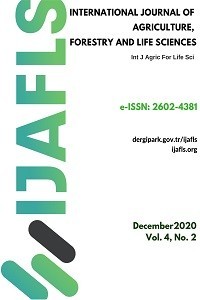CONSUMER PREFERENCES OF ORGANIC PRODUCTS FOR ROMANIA
CONSUMER PREFERENCES OF ORGANIC PRODUCTS FOR ROMANIA
The holistic production systems have been gaining more attention from the agricultural producer. This is due to the rising demand from the society and attached with increasing health concerns. While this is valid for developed countries, it is also gaining attention in developing countries as well. Driving out of these facts, it was intended to overview the consumer decision making process for organic agricultural products, specifically fresh fruits and vegetables and legumes by utilising primary data retrieved from Timisoara province of Romania. Due to the survey results of 2018, it was understood that demand for organic agriculture and its outputs is still a quality-price comparison matter for consumers and people with lower per capita income require price motivators. Yet, with rising income and level of education, quality-price assessment becomes more prevalent and people demand more variety of products. This confirms the income-demand co-movement for non-conventional products. It was understood that there is an interest for organic agricultural and food products in Romania as well, yet the level information is limited. Consumers are willing to be acknowledged but do not consider the conventional promotion tools as satisfactory. Non-conventional tools and increased consumer awareness are essential to increase the demand and corresponding farmer orientation on organic agricultural production.
Keywords:
organic agricultural products, demand, marketing, producer supports,
___
- Bagozzi, R.P., Dholakia, U.M., 1999. Goal setting and goal striving in consumer behavior. Journal of Marketing 63:19-32.
- Maggie, K.L., Ajuruchukwu, O., 2014. Analysis of Production and Consumption of Organic Products in South Africa. In Organic Agriculture Towards Sustainability, Edited by: Prof. Vytautas Pilipavicius. ISBN: 978-953-51-1340-9, In Tech, DOI: 10.5772/58356.
- Maxwell, S. 2001. An expanded price/brand effect model. A demonstration of heterogeneity in global consumption. International Marketing Review 18(3):325-343.
- Soderlund, M., 1998. Customer satisfaction and its consequences on customer behaviour revisited: The impact of different levels of satisfaction on word‐of‐mouth, feedback to thesupplier and loyalty. International Journal of Service Industry Management 9(2):169-171.
- Mulero, J., Pardo, F., Zafrilla, P., 2010. Antioxidant activity and phenolic composition of organic and conventional grapes and wines. Journal of Food Composition and Analysis 23(6):569–574. ISSN 1096-0481.
- Morris, C., Hopkins, A., Winter, M., 2001. Comparison of the Social, economic and environmental effects of organic, ICM and conventional farming. Final Report to the Countryside Agency, Institute of Grassland and Environmental Research, 155p.
- Gil, J.M., Gracia A., Sanchez M., 2000. Market segmentation and willingness to pay for organic products in Spain. International Food and Agribusiness Management Review 3(2): 207-226.
- Johansson J., 1999. Organic farming possibilities to increase organic cereals production in Skåne: A comparative study of Sweden and Denmark. MSc, Lund University, International Institute for Industrial Environmental Economics, Lund (2000:4), 71pp.
- Inci, H., Karakaya, E, Şengül, A.Y., 2017. Organik ürün tüketimini etkileyen faktörler (Diyarbakır ili örneği) – Factors affecting organic product consumption (example from Diyarbakir province). KSU J. Nat. Sci 20(2):137-147.
- Kozelová, D., Fikselová, M., Vietoris, V., Czako, P., 2013. Analysis of the Slovak consumer behaviour regarding the organic food purchase. Acta Univ. Agric. Silvic. Mendelianae Brun 61:2343-2350.
- Myers, S., Rorie, S., 2000. Facts and Stats: the Year in Review. Organic & Natural News 20-25.Vandeman, A., Hayden, B., 1997. New law paves way for expanding organic market. Food Review: The Magazine of Food Economics 20(2):28-32.
- Roman, G.V., 2010. Ituaţia Agriculturii Ecologice în România. [cit. 2014–08–15]; (cited in: Vietoris et al. 2016.)
- Dabija, D.C., Pop, N. Al, 2013. The Changing Business Landscape of Romania, Lessons for and from Transition Economies, Edited by: Thomas AR, Pop N Al, Constantin B., Springer, New York, pp. 45-60.
- Vietoris, V., Kozelová. D., Mellen, M., Chreneková, M., Potclan, J.E., Fikselová, M., Kopkáš, P., Horská, E., 2016. Analysis of consumer preferences at organic food purchase in Romania. Pol. J. Food Nutr. Sci. 66(2): 139–146
- Krystallis, A., Chryssohoidis G., 2005. Consumers' willingness to pay for organic food: Factors that affect it and variation per organic product type. British Food Journal 107(5): 320-343.
- Dahl D., 2014. Social influence and consumer behavior. Journal of Consumer Research 40(2): iii-v.
- Likert, R., 1967. The Method of Constructing an Attitude Scale. Readings in Attitude Theory and Measurements. John Wiley and Sons Inc., New York, pp. 90-95.
- Pearson, K., 1920. Notes on the history of correlation. Biometrika 13:25-45.
- Blyth, S.J., 1994a. Karl Pearson and the correlation curve. International Statistical Review/ Revue Internationale de Statistique 62(3):393-403.
- Moore, D. and McCabe, G., 2003. Introduction to the Practice of Statistics. 4th ed., W. H. Freeman and Company.
- Kurtulus, K., 1998. Pazarlama Arastirmalari – Marketing Research. Avciol Basim Yayin, Genisletilmis Altinci Baski, Istanbul.
- Zimmerman, D.W., 1994. A note on modified rank correlation. Journal of Educational and Behavioral Statistics 19(4): 357-362.
- Blyth, S.J., 1994b. Measuring Local association: An introduction to the correlation curve. Methodology 24:171-197.
- Kotler, P., 1997. Marketing Management: Analysis, Planning, Implementation and Control. International Ninth ed, Prentice Hall.
- Vega-Zamora, M., Torres-Ruiz, F.J., Murgado-Armenteros, E.M., Parras-Rosa, M., 2014. Organic as a heuristic cue: What Spanish consumers mean by organic foods. Psychol. Marketing 31(5):349–359.
- Anonymous, 2017. Eurostat data retrieved on 21.03.2018 from (Based on 1 Lei= 0.214257793 Euros): http://appsso.eurostat.ec.europa.eu/nui/show.do?dataset=nama_10_pc&lang=en
- Yayın Aralığı: Yılda 2 Sayı
- Başlangıç: 2017
- Yayıncı: Volkan OKATAN
Sayıdaki Diğer Makaleler
PRESENT CONDITION OF APPLE PRODUCTION IN UŞAK PROVINCE
Ercan YILDIZ, Ayşen Melda ÇOLAK
POSSIBILITIES OF YEAR-ROUND ROMAINE LETTUCE PRODUCTION IN NORTH CYPRUS
Turgut ALAS, İbrahim KAHRAMANOĞLU, Nihat YILMAZ, Serhat USANMAZ, Kazım ABAK
Sahriye SÖNMEZ, Taner AKAR, Erbil DEMİR
Jessie SABIJON, Michael Adonis SUDARIA
SOCIODEMOGRAPHIC CHARACTERISTICS OF SMALL RUMINANT FARMERS: ŞIRNAK PROVINCE SAMPLE
Asli KACAR, Sibel AVUNDUK, Burcu OMUZBUKEN, Eray AYKIN
EFFECT OF CLIMATE CHANGE ON MUNGBEAN GROWTH AND PRODUCTIVITY UNDER EGYPTIAN CONDITIONS
Ezzat ABD EL LATEFF, Mostafa ABD EL-SALAM, Mostafa SELIM, Medhat TAWFIK, Mohamad EL-KRAMANY, Aziza FARRAG
